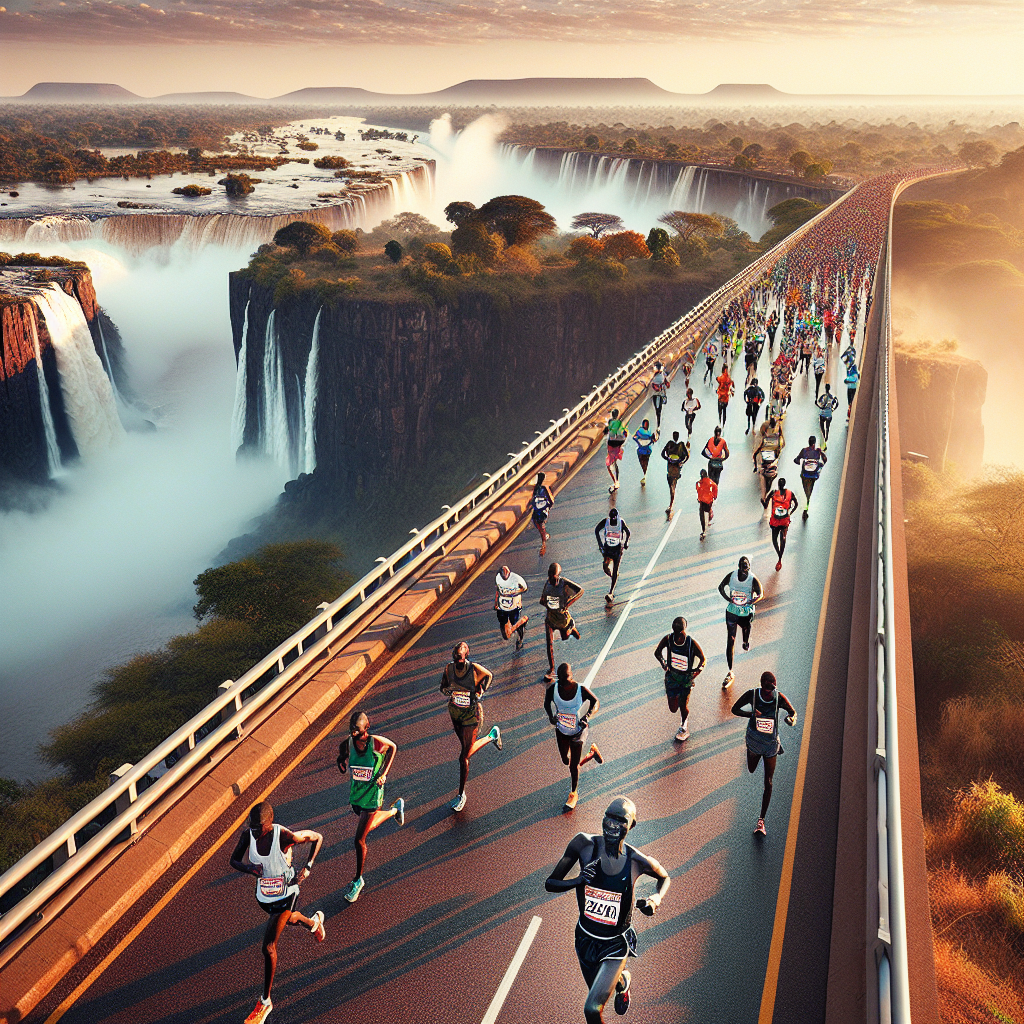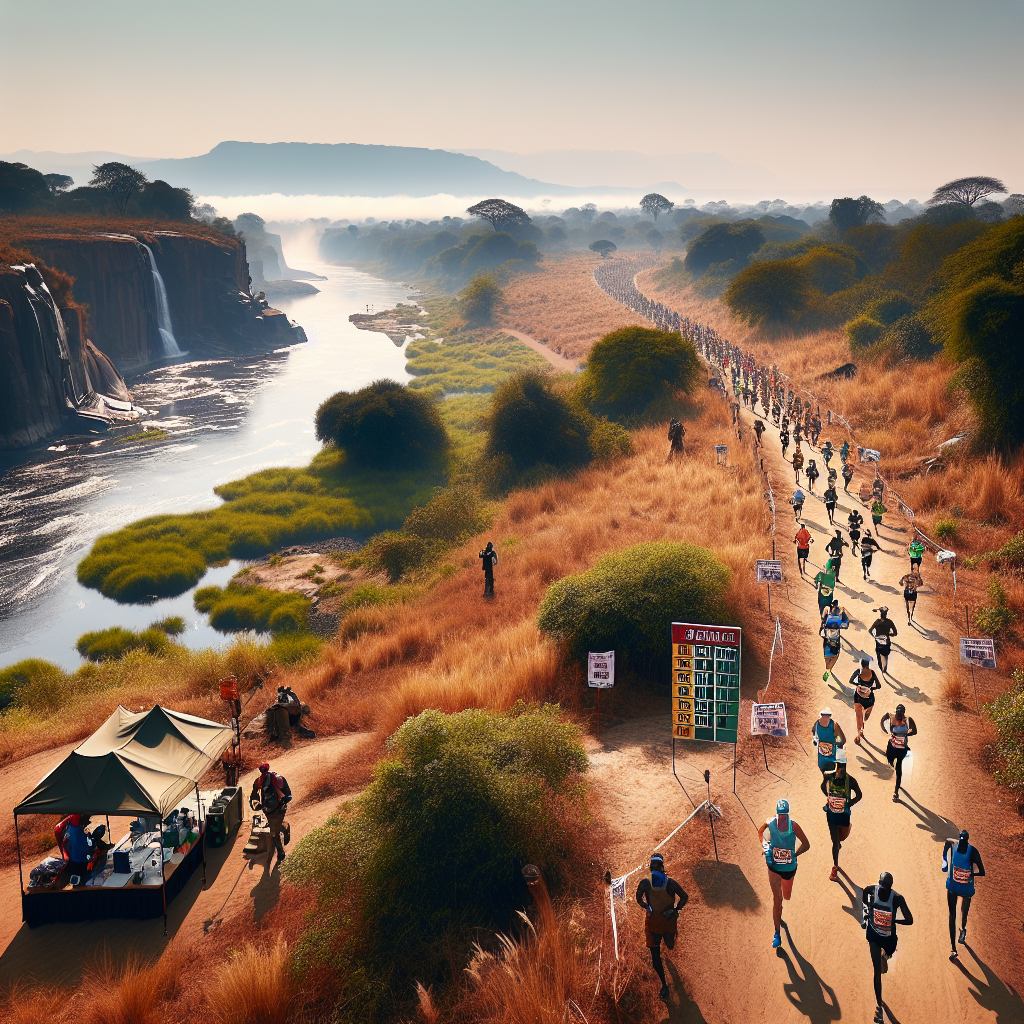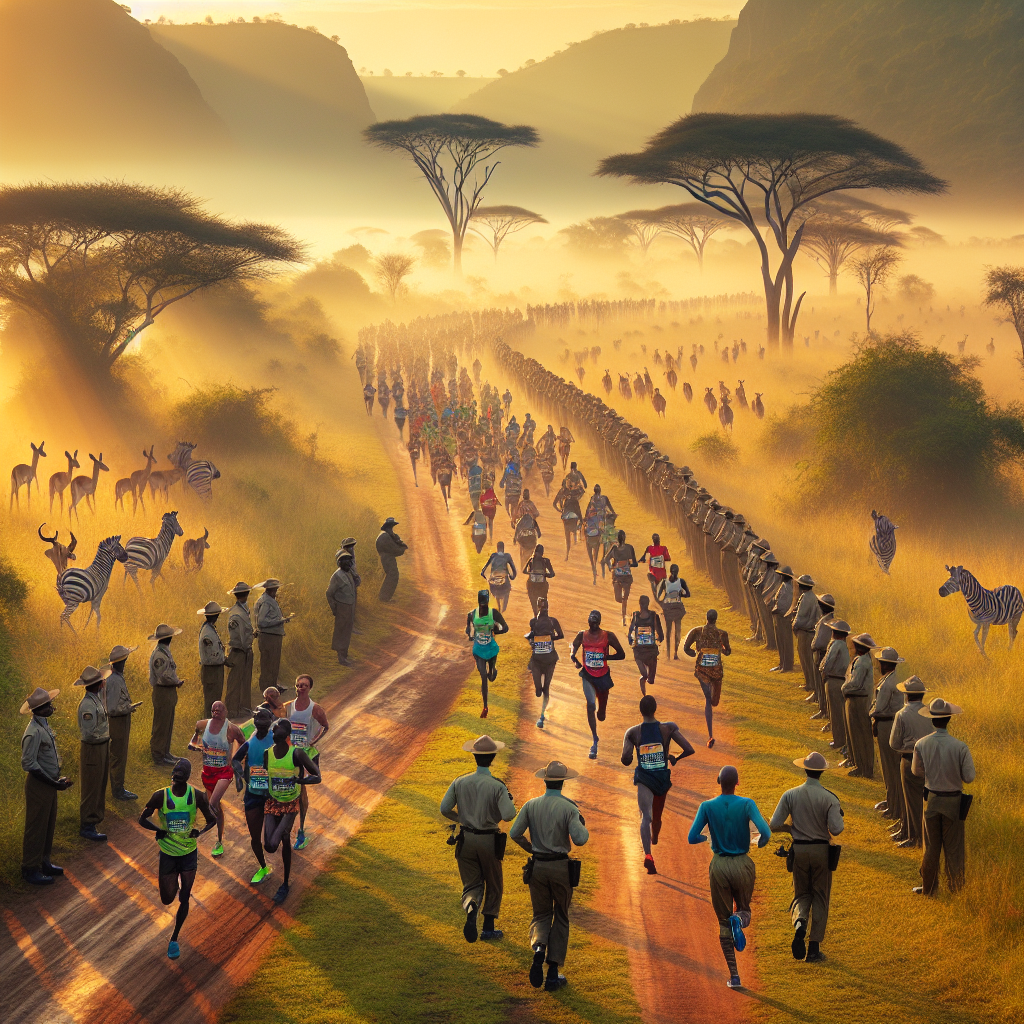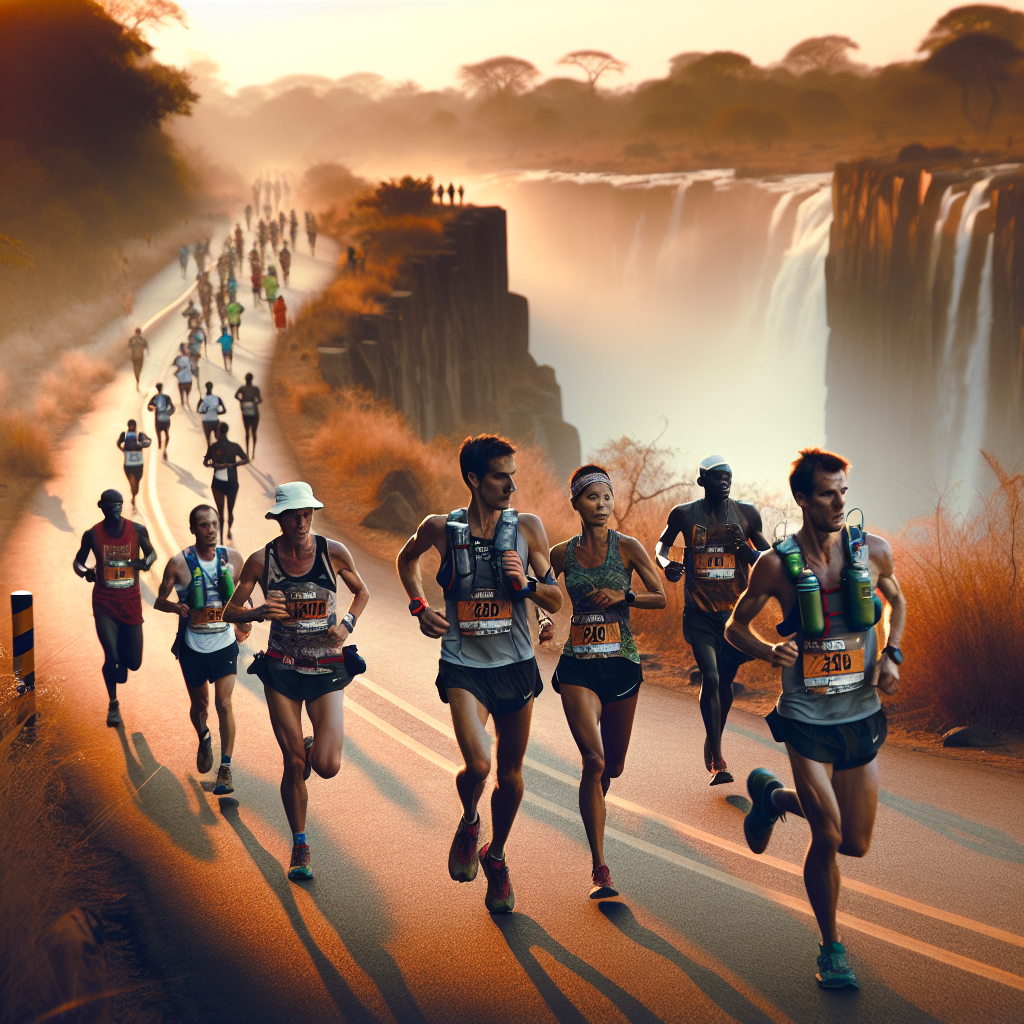Crossing between Zimbabwe and Zambia, the Victoria Falls Marathon delivers a challenging mix of city streets, natural paths, and the spectacular Victoria Falls Bridge, featuring a 230-meter elevation gain.
Victoria Falls Marathon: A Unique Cross-Border Challenge
The route takes runners past gentle slopes along the Zambezi River, through untamed African bushland, and across varied surfaces that test every runner’s abilities while delivering breathtaking views of the wild surroundings.
Key Takeaways
- The route includes a mix of surfaces from paved roads to compact dirt paths and rocky terrain
- Runners cross the historic Victoria Falls Bridge connecting Zimbabwe and Zambia
- The course presents a moderate challenge with 230-meter elevation gain throughout
- Technical sections between kilometers 25–32 feature the most challenging climbs
- Early morning starts provide optimal running conditions before intense midday heat
A Scenic and Varied Course
The trail shifts between urban areas and natural landscapes, creating an exciting blend of running conditions. Runners experience surfaces ranging from smooth pavement to rugged dirt paths. The iconic bridge crossing stands as a highlight, connecting two nations while offering stunning views of Victoria Falls far below.
Challenging and Rewarding Terrain
Each segment of the course brings its own distinct character. The riverside portions offer scenic, flat stretches, while the bushland areas demand extra attention to footing. The section between kilometers 25 and 32 features the most rigorous climbs, where technical terrain truly tests a runner’s endurance.
Strategic Start Times
Starting in the early morning sunshine enables participants to tackle the course before the African heat intensifies. This strategic timing helps runners maintain crucial energy levels and enhances the experience of a race that is both physically rigorous and visually unforgettable. The varied terrain and elevation changes deliver an authentic African marathon adventure connected to the raw beauty of one of nature’s most stunning locations.
Running Through One of Africa’s Natural Wonders
The Victoria Falls Marathon course lets you chase your running goals while soaking in the raw beauty of one of Africa’s greatest natural spectacles. The terrain creates a perfect mix of challenge and inspiration as you train for this remarkable marathon experience.
Natural Landmarks and Border Crossings
Your run starts near the thundering Victoria Falls, where the mist creates a unique microclimate that adds an extra layer of refreshment to your race experience. The route spans two countries, taking you across the historic Victoria Falls Bridge that connects Zimbabwe and Zambia. This architectural marvel gives you a spectacular vantage point of the falls and the rushing Zambezi River below.
Elevation and Course Profile
The course presents a moderate challenge with its 230-meter elevation gain. I’ve found that proper training for elevation changes makes a significant difference in performance. The terrain varies throughout the route, featuring:
- Gentle rolling hills along the Zambezi River banks
- A notable climb across the Victoria Falls Bridge
- Mixed surfaces including paved roads and compact dirt paths
- Several flat sections perfect for maintaining steady pace
- Strategic downhill portions for recovery
Wildlife sightings add an extra thrill to your run – you might spot elephants, zebras, or various bird species along the course. The combination of natural wonders and varied terrain makes this marathon a bucket-list worthy event for any aspiring marathon runner.

From Urban Streets to Wild Terrain
The Victoria Falls Marathon kicks off from the bustling center of Livingstone, taking runners past local shops and historical buildings that showcase the town’s colonial architecture. The initial stretch winds through charming residential neighborhoods on well-maintained tarmac roads, letting participants find their rhythm before tackling the more challenging sections ahead.
Nature’s Running Track
As the race progresses, I’ve found that the terrain shifts dramatically from urban pavement to natural dirt paths cutting through authentic African bushland. This raw, untamed section of the course creates an incredible running adventure through wilderness that few other marathons can match. The route offers these distinct features that make it special:
- Unpaved trails that weave through native acacia woodlands and grasslands
- Natural elevation changes that add an extra layer of challenge
- Sections alongside game viewing areas where wildlife roams freely
- Traditional villages where locals gather to cheer and play drums
- Strategic viewpoints overlooking the Zambezi River
Wildlife sightings add an extra thrill to the race experience. Runners might spot elephants grazing in the distance, zebra herds crossing nearby plains, or giraffes peering over treetops. Local spectators create an energetic atmosphere with traditional drumming and dancing at various points along the course, making this marathon experience uniquely African. Security teams monitor the course to ensure runner safety, particularly in areas where wildlife activity is common.
The mixed terrain demands versatile running shoes that can handle both paved roads and dirt trails. I recommend training on similar mixed surfaces to prepare for race day conditions and carrying hydration supplies, as the African sun can be intense, especially during the unpaved sections where shade is limited.
Mastering the Marathon’s Challenging Sections
Early Course Profile and Conditions
The Victoria Falls Marathon starts with a deceptively gentle profile. I’ve found the first half of the course offers runners a perfect opportunity to establish their race rhythm with relatively flat terrain and subtle inclines. The morning temperatures provide ideal running conditions, though you’ll need to prepare for significant warming as the day progresses.
Technical Challenges and Key Segments
The real test comes between kilometers 25-32, where a substantial climb puts even experienced marathoners to the test. This section demands smart pacing and strong hill-running skills. Here are the key terrain features you’ll encounter:
- Rocky paths and gravel sections through bush areas require careful foot placement
- Bridge crossings can become slick from the falls’ mist, calling for adjusted stride length
- Temperature shifts from cool morning starts to intense midday heat demand flexible race strategy
- Natural obstacles and uneven surfaces throughout the bush sections need constant attention
The challenging terrain makes this marathon uniquely different from standard road races. I recommend incorporating hill training and mixed-surface running into your marathon preparation to build the specific strength needed for these conditions. The combination of technical trail sections, elevation changes, and variable weather creates a course that tests both physical endurance and technical running ability.
Riverside Running and Natural Obstacles
Running Along the Zambezi
The Victoria Falls Marathon route connects runners with nature through several kilometers of riverside terrain along the mighty Zambezi. The path follows natural contours of the riverbank, creating an authentic African running experience that’s both scenic and challenging. Sandy patches occasionally interrupt the otherwise stable ground, requiring careful footwork and adjusted pacing. I’d recommend practicing on similar terrain before race day by incorporating varied surfaces into your training runs.
Course Support and Safety Features
The course infrastructure has been carefully planned with runner safety in mind, especially considering the unique terrain challenges. Here’s what you’ll find along the route:
- Water stations positioned every 3 kilometers, letting you stay hydrated without carrying excess weight
- Clear distance markers guiding your progress throughout the course
- Warning signs indicating wildlife areas for added safety
- Medical stations strategically placed at technically demanding sections
The combination of natural obstacles and wildlife considerations makes this marathon uniquely challenging for first-timers. I suggest taking advantage of the frequent water stations, as the terrain can demand extra energy compared to standard road marathons. The course’s natural elements create a rewarding challenge that lets you experience the raw beauty of Africa while testing your endurance.

Conservation Areas and Protected Zones
Wildlife Protection Measures
A significant portion of the Victoria Falls Marathon route cuts through protected national parkland, making this race truly special but requiring strict adherence to conservation protocols. Park rangers strategically position themselves along known wildlife corridors to monitor both runner safety and animal movements throughout the race duration.
I’ve found that the designated path system plays a crucial role in maintaining runner safety and environmental protection during the event. These carefully marked trails ensure participants don’t disturb the natural habitat while still experiencing the raw beauty of African wilderness.
The race organizers have implemented several key conservation measures to protect the local ecosystem:
- Early morning start times coordinated with wildlife behavior patterns
- Trained rangers stationed at critical crossing points
- Clearly marked paths with temporary barriers in sensitive areas
- Limited number of race participants to reduce environmental impact
- Water stations positioned away from known animal gathering spots
The early sunrise start isn’t just about beating the heat – it’s carefully timed to minimize disruption to wildlife in the park. Most large animals are less active during these hours, reducing the chance of unexpected encounters between runners and wildlife.
The terrain itself varies from smooth tarmac to packed dirt trails within the conservation area. Each section has been carefully selected to balance the athletic challenge with environmental preservation. Special access permits are secured months in advance to ensure all conservation guidelines are met while allowing runners to experience this unique African marathon setting.

Preparing for Victoria Falls’ Unique Conditions
Essential Gear and Weather Considerations
Trail running shoes are a must-have for tackling the mixed surfaces along the Victoria Falls Marathon route. I recommend shoes with good grip and stability features since you’ll encounter both paved roads and unpaved sections. The terrain shifts between smooth tarmac near town areas to packed dirt paths as you pass through more remote sections.
The race conditions demand smart preparation, particularly for managing heat and humidity. Here’s what you need to know about the environmental factors:
- Temperature typically stays between 15-25°C on race morning
- Humidity levels can change rapidly as you pass near the falls
- The course closes after 6 hours to ensure runner safety from wildlife
- Natural lighting from the early sunrise aids visibility throughout the run
Your hydration strategy needs special attention for this marathon training journey. I suggest carrying a personal water supply even though there are aid stations along the route. The varying humidity near the falls can affect your hydration needs differently than what you might be used to in your regular training sessions.
The early morning start takes advantage of natural lighting and cooler temperatures, making the first few hours ideal for maintaining a steady pace. As a beginner marathon runner, you’ll appreciate these favorable morning conditions while adapting to the unique terrain challenges.
The 6-hour course closure is strictly enforced due to wildlife activity in the area. This time limit requires maintaining a consistent pace throughout the race, so I recommend practicing your pacing during your running preparation to ensure you can complete the course within the allocated time frame.

Sources:

